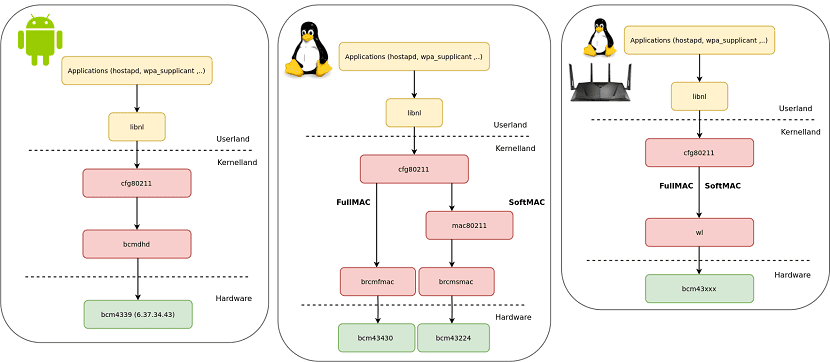
A few days ago, the news broke that the drivers for Broadcom wireless chips four vulnerabilities were detected, who allow remote attacks to be carried out on devices that include these chips.
In the simplest case, vulnerabilities can be used for denial of service remote, but scenarios in which vulnerabilities can develop are not excluded that allow an unauthenticated attacker to run your code with the privileges of the Linux kernel by sending specially crafted packages.
These issues were identified during Broadcom's firmware reverse engineering, where vulnerability-prone chips are widely used in laptops, smartphones, and various consumer devices, from SmartTV to IoT devices.
In particular, Broadcom chips are used in the smartphones of manufacturers such as Apple, Samsumg and Huawei.
Notably Broadcom was notified of the vulnerabilities in September 2018, but it took approximately 7 months (that is to say just in this month in progress) launch corrections coordinated with the equipment manufacturers.
What are the detected vulnerabilities?
Two vulnerabilities affect the internal firmware and potentially allow code execution in the operating system environment used in Broadcom chips.
As Allows attacking non-Linux environments (For example, the possibility of an attack on Apple devices, CVE-2019-8564 is confirmed)).
Here it is important to note that some Broadcom Wi-Fi chips are a specialized processor (ARM Cortex R4 or M3), which will run the similarity of your operating system from implementations of its 802.11 wireless stack (FullMAC).
In said chips, controller provides host system interaction with chip firmware Wi-Fi access.
In the description of the attack:
To gain full control over the main system after FullMAC is compromised, it is proposed to use additional vulnerabilities or full access to system memory on some chips.
In SoftMAC chips, the 802.11 wireless stack is implemented on the controller side and is run by a system CPU.
In the controllers, vulnerabilities manifest both in wl's proprietary driver (SoftMAC and FullMAC) as in the open brcmfmac (FullMAC).
In the wl driver, two buffer overflows are detected, exploited when the access point sends specially crafted EAPOL messages during the connection negotiation process (an attack can be performed by connecting to a malicious access point).
In the case of a chip with SoftMAC, the vulnerabilities lead to a compromise of the system kernel, and in the case of FullMAC, the code can run on the firmware side.
In brcmfmac, there is a buffer overflow and an error checking for processed frames, which are exploited by sending control frames. In the Linux kernel, problems in the brcmfmac driver were fixed in February.
Identified vulnerabilities
The four vulnerabilities that were disclosed since September last year, they are already cataloged in the following CVEs.

CVE-2019-9503
The incorrect behavior of the brcmfmac driver when processing control frames used to interact with the firmware.
If a frame with a firmware event comes from an external source, the controller discards it, but if the event is received through the internal bus, the frame is ignored.
The problem is that events from devices using USB are transmitted over the internal bus, allowing attackers to successfully transfer firmware which controls the frames in the case of using USB wireless adapters;
CVE-2019-9500
When you activate the function "Wake-up on Wireless LAN", may cause an overflow in the brcmfmac controller (function brcmf_wowl_nd_results) sending a specially modified control framework.
This vulnerability can be used to organize code execution on the host after chip engagement or in combination.
CVE-2019-9501
The buffer overflow in the wl driver (wlc_wpa_sup_eapol function), which occurs during message processing, the content of the manufacturer information field in which exceeds 32 bytes.
CVE-2019-9502
The buffer overflow in the wl driver (wlc_wpa_plumb_gtk function), which occurs during message processing, the content of the manufacturer information field in which exceeds 164 bytes.
Source: https://blog.quarkslab.com